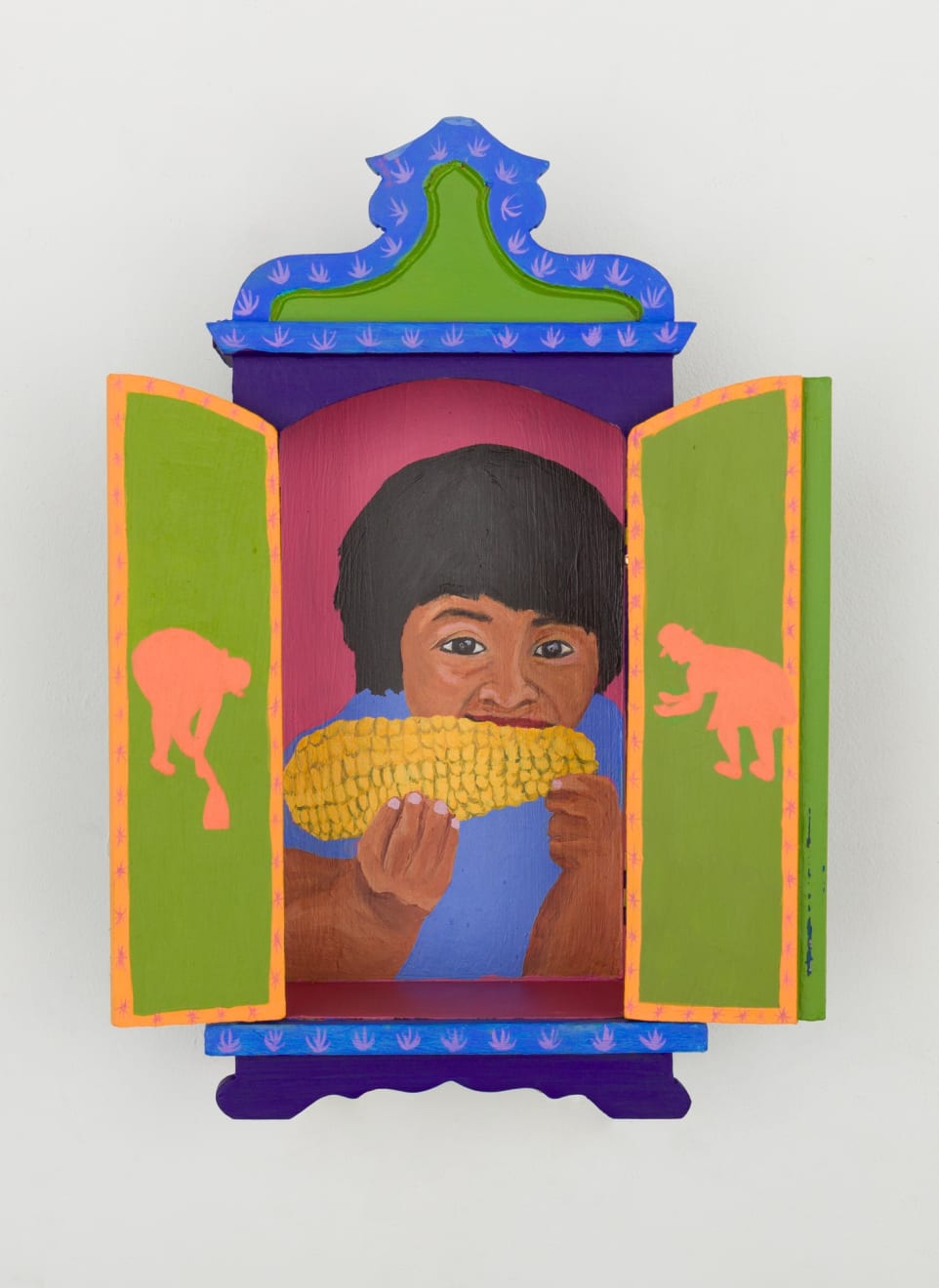Yanaki Herrera
Choclo, 2024
acrílica sobre oratório de madeira
[acrylic on wooden oratory]
[acrylic on wooden oratory]
35.5 x 25 x 11 cm aberto
35.5 x 17.5 x 10 cm fechado
[14 x 9 7/8 x 4 3/8 in open
14 x 6 7/8 x 4 in closed]
1.0 kg
35.5 x 17.5 x 10 cm fechado
[14 x 9 7/8 x 4 3/8 in open
14 x 6 7/8 x 4 in closed]
1.0 kg
Copyright O Artista
Mais imagens
Na série CHOCLO, PUÑO Y VOZ, Yanaki Herrera se inspira nos princípios do Sumak Kawsay (bem viver), que constata a reciprocidade e comunidade como práticas fundamentais. A criação imagética dos...
Na série CHOCLO, PUÑO Y VOZ, Yanaki Herrera se inspira nos princípios do Sumak Kawsay (bem viver), que constata a
reciprocidade e comunidade como práticas fundamentais. A criação imagética dos oratórios parte da mistura entre o auto retrato, o retrato do seu filho Amaru, além de alguns elementos que fazem parte de seu cotidiano, como a máscara contemporânea de super herói. Também, elementos que participaram de sua infância, como a cerâmica ancestral Mochica (Peru), entre outros.
As narrativas materializadas nesta obra referem a convivência entre a artista e seu filho, e o ato contínuo da alimentação, da luta e da brincadeira como modos fundamentais baseadas no encontro entre o pensar e sentir para ser. Esta série utiliza como suporte os oratórios de madeira, gesto de apropriação do objeto, com o intuito de gerar uma quebra de expectativa quando visto de portas abertas.
[In the series CHOCLO, PUÑO Y VOZ, Yanaki Herrera is inspired by the principles of Sumak Kawsay (good living), which sees
reciprocity and community as fundamental practices. The imagery of the oratories is based on a mixture of her self-portrait, the portrait of her son Amaru, as well as some elements that are part of his daily life, such as the contemporary superhero mask. Also, elements that were part of her childhood, such as ancestral Mochica ceramics (Peru), among others.
The narratives of this work refer the coexistence between the artist and her son, and the continuous act of feeding, fighting and playing as fundamental modes based on the encounter between thinking and feeling in order to be. This series uses wooden oratories as a support, a gesture of appropriation of the object, with the aim of generating a breach of expectation when seen through open doors.]
reciprocidade e comunidade como práticas fundamentais. A criação imagética dos oratórios parte da mistura entre o auto retrato, o retrato do seu filho Amaru, além de alguns elementos que fazem parte de seu cotidiano, como a máscara contemporânea de super herói. Também, elementos que participaram de sua infância, como a cerâmica ancestral Mochica (Peru), entre outros.
As narrativas materializadas nesta obra referem a convivência entre a artista e seu filho, e o ato contínuo da alimentação, da luta e da brincadeira como modos fundamentais baseadas no encontro entre o pensar e sentir para ser. Esta série utiliza como suporte os oratórios de madeira, gesto de apropriação do objeto, com o intuito de gerar uma quebra de expectativa quando visto de portas abertas.
[In the series CHOCLO, PUÑO Y VOZ, Yanaki Herrera is inspired by the principles of Sumak Kawsay (good living), which sees
reciprocity and community as fundamental practices. The imagery of the oratories is based on a mixture of her self-portrait, the portrait of her son Amaru, as well as some elements that are part of his daily life, such as the contemporary superhero mask. Also, elements that were part of her childhood, such as ancestral Mochica ceramics (Peru), among others.
The narratives of this work refer the coexistence between the artist and her son, and the continuous act of feeding, fighting and playing as fundamental modes based on the encounter between thinking and feeling in order to be. This series uses wooden oratories as a support, a gesture of appropriation of the object, with the aim of generating a breach of expectation when seen through open doors.]











